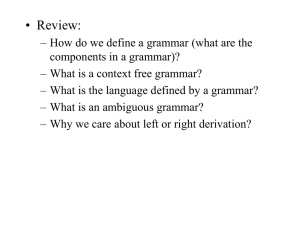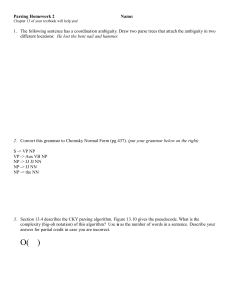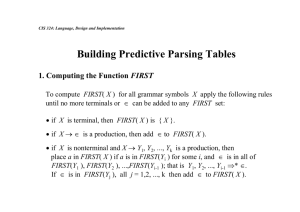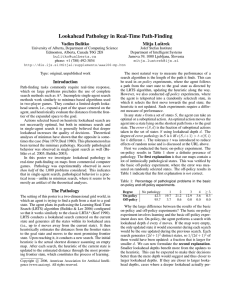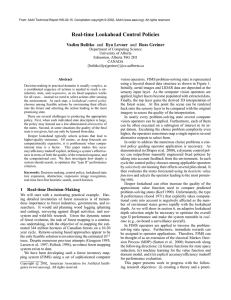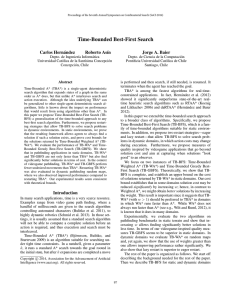COP4020 Programming Languages Parsing
advertisement
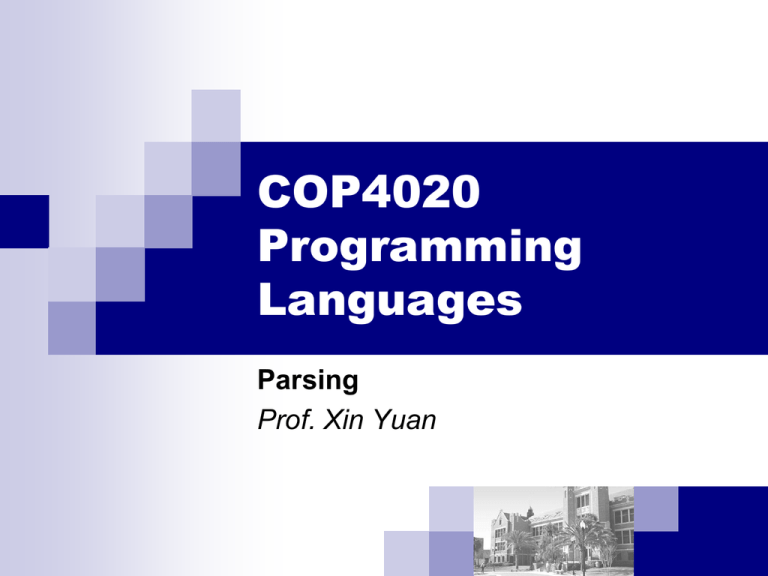
COP4020
Programming
Languages
Parsing
Prof. Xin Yuan
Overview
Top-down and bottom-up parsing
Recursive descent parsing
Table driven LL(1) parsing
5/29/2016
COP4020 Spring 2014
2
Parsing:
The process to determine whether the start symbol can
derive the program.
If successful, the program is a valid program.
If failed, the program is invalid.
Two approaches in general.
Expanding from the start symbol to the whole program (top down)
Reduction from the whole program to start symbol (bottom up).
<expression>
<expression>
<operator>
<expression>
<expression> <operator> <expression>
identifier
*
identifier
+
identifier
Top-down parsing
build the parse tree from root to leave (using leftmost
derivation, why?).
Recursive descent parser
LL parser
First L – left to right scan
Second L – left most derivation
Recursive descent parsing associates a procedure with each
nonterminal in the grammar, it may require backtracking of
the input string.
Example: <type>-><simple> | ^ id | array [<simple>] of <type>
<simple> ->integer | char | num dotdot num
void type() {
if (lookahead == INTEGER || lookahead == CHAR || lookahead==NUM)
simple();
else if (lookahead == ‘^’) {
match (‘^’);
match(ID);
} else if (lookahead == ARRAY) {
match (ARRAY);
match(‘[‘);
simple();
match (‘]’);
match (OF);
type();
} else error();
}
Example: <type>-><simple> | ^ id | array [<simple>] of <type>
<simple> ->integer | char | num dotdot num
void simple() {
if (lookahead == INTEGER) match (INTEGER);
else if (lookahead == CHAR) match (CHAR);
else if (lookahead == NUM) {
match(NUM);
match(DOTDOT);
match(NUM);
} else error();
}
void match(token t) {
if (lookahead == t) {lookahead = nexttoken();}
else error();
}
Recursive descent parsing may require backtracking of the
input string
try out all productions, backtrack if necessary.
E.g S->cAd, A->ab | a
input string cad
A
special case of recursive-descent parser that
needs no backtracking is called a predictive
parser.
Look at the input string, must predict the right production every time
to avoid backtracking – LL(1)
Needs to know what first symbols can be generated by the right side of a
production only lookahead for one token
Non recursive predictive parsing (table driven
LL(1) parsing)
Predictive parser can be implemented by recursive-descent
parsing
Requirement: by looking at the first terminal symbol that a
nonterminal symbol can derive, we should be able to choose the
correct production to expand the nonterminal symbol.
If the requirement is met, the parser easily be implemented
using a non-recursive scheme by building a parsing table.
A parsing table example
(1) E->TE’
(2) E’->+TE’
(3) E’->
(4) T->FT’
(5) T’->*FT’
(6) T’->
(7) F->(E)
(8) F->id
E
E’
T
T’
F
id
(1)
+
*
(
(1)
(2)
(4)
$
(3)
(3)
(6)
(6)
(4)
(6)
(8)
)
(5)
(7)
Using the parsing table, the predictive
parsing program works like this:
A stack of grammar symbols ($ on the
bottom)
A string of input tokens ($ at the end)
A parsing table, M[NT, T] of productions
Algorithm:
put ‘$ Start’ on the stack ($ is the end
of input string).
1) if top == input == $ then accept
2) if top == input then
pop top of the stack; advance to next
input symbol; goto 1;
3) If top is nonterminal
if M[top, input] is a production then
replace top with the production; goto 1
else error
4) else error
Example:
(1) E->TE’
(2) E’->+TE’
(3) E’->
(4) T->FT’
(5) T’->*FT’
(6) T’->
(7) F->(E)
(8) F->id
Stack
$E
$E’T
$E’T’F
$E’T’id
$E’T’
…...
E
E’
T
T’
F
id
(1)
+
*
(
(1)
(2)
(4)
input
id+id*id$
id+id*id$
id+id*id$
id+id*id$
+id*id$
$
(3)
(3)
(6)
(6)
(4)
(6)
(8)
)
(5)
(7)
production
E->TE’
T->FT’
F->id
This produces leftmost derivation:
E=>TE’=>FT’E’=>idT’E’=>….=>id+id*id
